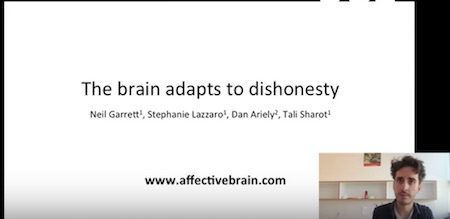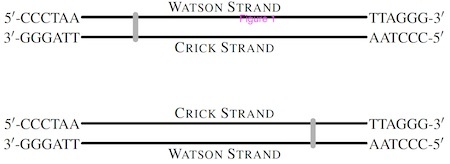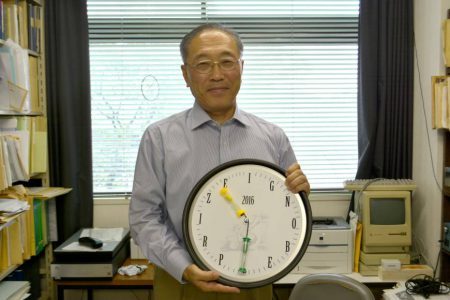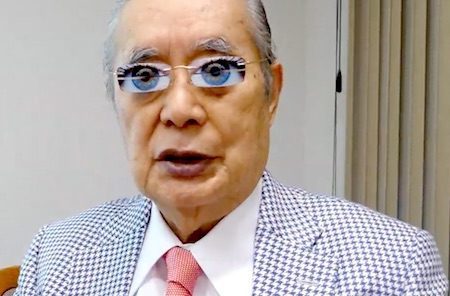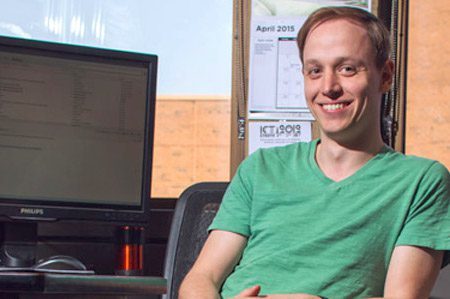Marc Abrahams's Blog, page 243
October 25, 2016
A feisty embuggerance
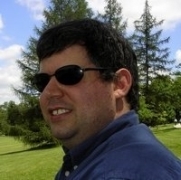 Stephen Chrisomalis [pictured here] writes, in the Glossographia blog, about feisty embuggerance:
Stephen Chrisomalis [pictured here] writes, in the Glossographia blog, about feisty embuggerance:
When I grade my students’ paper proposals, I make a point of doing a brief Google Scholar search for each student’s proposal, which a) helps me evaluate how thorough they have been; b) helps me help them find additional material (I then give them the sources I found, but also the keywords I used to find them). One of my students in my introductory linguistic anthropology course this term is doing a paper on linguistic aspects of laughter and humor. During my search, I encountered the following citation (direct from Google Scholar to you):
Embuggerance, E., and H. Feisty. 2008. The linguistics of laughter. English Today 1, no. 04: 47-47.
After I stopped laughing, I set to figuring out what was going on….
(Thanks to investigator Scott Langill for bringing this to our attention.)

October 24, 2016
Further prying insights on lying
Ig Nobel Prize winner Dan Ariely and colleagues have a new study about lying: “The Brain Adapts to Dishonesty,” by Neil Garrett, Stephanie Lazzaro, Dan Ariely, and Tali Sharot, published in Nature Neuroscience.
A news report in Scientific American sums it up: “The team’s findings, published today in Nature Neuroscience, confirm in a laboratory setting that dishonesty grows with repetition. The researchers also used brain imaging to reveal a neural mechanism that may help explain why.”
Co-author Garrett describes what the team did and found, in this video:
Dan Ariely and three other colleagues were awarded the 2008 Ig Nobel Prize for medicine, for demonstrating that high-priced fake medicine is more effective than low-priced fake medicine. (Their study about that: “Commercial Features of Placebo and Therapeutic Efficacy,” Rebecca L. Waber; Baba Shiv; Ziv Carmon; Dan Ariely, Journal of the American Medical Association, March 5, 2008; 299: 1016-1017.)
BONUS: Two of this year’s Ig Nobel Prize winners did research on related topics:
2016 Ig Nobel Psychology Prize — Evelyne Debey, Maarten De Schryver, Gordon Logan, Kristina Suchotzki, and Bruno Verschuere, for asking a thousand liars how often they lie, and for deciding whether to believe those answers. [“From Junior to Senior Pinocchio: A Cross-Sectional Lifespan Investigation of Deception,” Evelyne Debey, Maarten De Schryver, Gordon D. Logan, Kristina Suchotzki, and Bruno Verschuere, Acta Psychologica, vol. 160, 2015, pp. 58-68.]
2016 Ig Nobel Peace Prize — Gordon Pennycook, James Allan Cheyne, Nathaniel Barr, Derek Koehler, and Jonathan Fugelsang for their scholarly study called “On the Reception and Detection of Pseudo-Profound Bullshit”. [“On the Reception and Detection of Pseudo-Profound Bullshit,” Gordon Pennycook, James Allan Cheyne, Nathaniel Barr, Derek J. Koehler, and Jonathan A. Fugelsang, Judgment and Decision Making, Vol. 10, No. 6, November 2015, pp. 549–563.]

How to ‘cheat’ at sport without really ‘cheating’ – part 3: Grunting
Our previous Improbable article in this series examined the use of placebos – we now look at grunting. Though several sports tolerate (or even encourage) grunting as part of normal play, some have complained that it can be used as a deliberate and unfair distraction of one’s opponent(s). With regard to tennis for example, see: A Preliminary Investigation Regarding the Effect of Tennis Grunting: Does White Noise During a Tennis Shot Have a Negative Impact on Shot Perception? by S Sinnett, A Kingstone – PloS one, 2010.
“There is a growing chorus of critics who complain that many of the top-ranked professional tennis players who grunt when they hit the ball gain an unfair advantage because the sound of the grunt interferes with their opponent’s game.
[…]
Our data suggest that a grunting player has a competitive edge on the professional tennis tour.“
Although the global tennis authorities don’t (as far as Improbable can ascertain) have any specific rules relating to the distractions of grunting, some local associations have crafted their own code of conduct. See for example rule 36 of the Newbury and District Lawn Tennis Association, UK [.doc format]
“36. Grunting. A player should avoid grunting and making other loud noises. Grunting and other loud noises may bother not only opponents but also players on adjacent courts. In an extreme case, an opponent or a player on an adjacent court may seek the assistance of the Referee or a Roving Umpire. The Referee or official may treat grunting and the making of loud noises as a hindrance. Depending upon the circumstance, this could result in a let or loss of point. “
This concludes our short Improbable series on how to ‘cheat’ at sport without really ‘cheating’.
Bonus assignment [optional]: In which (if any) of the following competitive sports/games should grunting be banned? [give reasons].
•Pole vault •Curling• Synchronized swimming •Chess •Shooting •Golf •Tiddlywinks •Dressage

October 23, 2016
“Nuts!” (of/and goats, and dogs, etc., and people), the film
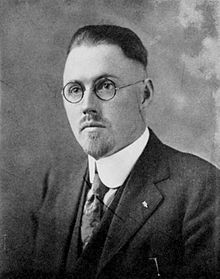 “In 1922, Brinkley traveled to Los Angeles at the invitation of Harry Chandler, owner of the Los Angeles Times, who challenged Brinkley to transplant goat testicles into one of his editors.”
“In 1922, Brinkley traveled to Los Angeles at the invitation of Harry Chandler, owner of the Los Angeles Times, who challenged Brinkley to transplant goat testicles into one of his editors.”
That’s just one nugget from the Wikipedia biography of “Doctor” John R. Brinkley, who lived a colorful life. Implanting goat testicles into strangers was not the half, or even fifth of it. Well, maybe the fifth of it.
A new documentary film called “Nuts!” chews over the life and claims and accomplishments of the not-so-good non-doctor. Here’s the trailer for the film:
(Thanks to Erwin Kompanje for bringing this to our attention.)

Multiple personalities in the Watson vs. Crick strand controversy
Dan Gaur, a member of the Luxuriant Former Hair Club for Scientists (LFHCfS), and a colleague published a paper on the (little-known) Watson-Crick controversy:
“The Multiple Personalities of Watson and Crick Strands,” Reed A. Cartwright and Dan Graur, Biology Direct, vol. 6, no. 7, 2011. The authors, at the University of Houston, explain:
“Background: In genetics it is customary to refer to double-stranded DNA as containing a ‘Watson strand’ and a ‘Crick strand.’ However, there seems to be no consensus in the literature on the exact meaning of these two terms, and the many usages contradict one another as well as the original definition. Here, we review the history of the terminology and suggest retaining a single sense that is currently the most useful and consistent.”
Here’s detail from the study:
BONUS: Here’s a short video documentary about Watson and Crick and their strands. The documentary is most notable from the apparently near-death qualities evident in the narrator’s voice:

October 22, 2016
20 questions answered by the man who looked at the world upside-down
Atsuki Higashiyama, winner of the 2016 Ig Nobel Prize for perception, answers 20 questions, in the Japan Times. It begins:
Ig Nobel perception prize winner Atsuki Higashiyama: ‘Psychology teaches us to be scientific and skeptical’
BY J.J. O’DONOGHUE
SPECIAL TO THE JAPAN TIMES
Name: Atsuki Higashiyama
Age: 65
Nationality: Japanese
Occupation: Professor of psychology, Ritsumeikan University
Likes: Walking, spending a whole day not thinking
Dislikes: Business, teaching
1. Please explain your research on perception. My research focuses on 3-D perception — the relationship between visual perception and body orientation.
2. Did you ever expect to win an Ig Nobel prize? No, never. It was a complete surprise.
3. What prize did you receive? I received 10 trillion Zimbabwean dollars, a 61-second clock, a certificate and a very warm welcome.
4. Describe the pose that is synonymous with your research. I sometimes, not often, take the pose of bending over and looking between my legs. I have encouraged participants of the experiments to take this pose for a very short elapsed time on every trial. If we kept this pose for a long time, the blood would pile in the brain, which should be avoided….
BONUS: Watch Professor Higashiyama receive the prize, in this video of the Ig Nobel Prize ceremony (the prize is announced at the 1:20:05 point in this video):

Testing the “Stick-on-the-wall Spaghetti rule”
by Simone Montangero, Francesca Vittone, and several Kindergarden Kids (Annalena, Giorgio, Jonathan, Klara, Lilith Milou, Jannes, Lilli, Finn, Marietta, Janto, Sophie, Moritz, Jonas)
Institute for Complex Quantum Systems, Ulm University
Ulm, Germany
There is always a moment when Italians abroad come across a local who explains to them a simple way of knowing how to cook Spaghetti “al dente”: throw them to the wall, if they stick they are ready to be eaten. After the first shock, they typically realize that this rule is worldwide known, while it is completely unknown in Italy where pasta is simply tasted. Being scientists we aim to test this rule to be able to refuse or accept it on solid ground. Moreover, we use this occasion to approach another common problem of scientists, that is, to explain to their young children what their parents do at work: we enrolled a class of preschoolers and show them how to experimentally test a belief with scientific rigor. We hope also to contribute to reduce the frustration of other scientists when their kids ask them about their jobs: long explanations typically result in a frustrated kid going away mumbling something about firemen or bus drivers…

Figure 1: Typical results of the experiment, with stuck spaghetti highlighted in green, failures in red.
Experiment. We test the Stick On the Wall Spaghetti (SOWS) rule with a box of standard Spaghetti “Barilla”, official cooking time 9 minutes as reported on the box. The Spaghetti are cooked for 3, 6, and 9 minutes, and then are thrown against three different kind of walls: a kitchen wall (KW), a window (F), and a whiteboard (T). We have a team of 13 throwers, preschool kids of ages between 5 and 7 years. Each thrower throws one spaghetti for each different cooking time and wall kind, for a total of 13x3x3=107 launches, which are subsequently recorded as successfully stuck or not. Figure 1, reports a typical experimental result together with typical experimental conditions. The collected raw data are reported in Figure 2, for different cooking times and wall types.

Figure 2: Histogram of the experiments results (0 means failure to, 1 success), for the three different wall types (from left to right: window, kitchen and whiteboard), different cooking times (3, 6, and 9 minutes: violet, blue and green).
The statistical analysis of the experimental data acquisition is presented in Figure 3 where we report the average probability to stick (ratio between the number of stuck spaghetti and the total number of thrown ones) as a function of the cooking time for the three different walls. As expected, in all scenarios the probability to stick (mostly) increases with time. We interpret this as a signal that no major failure occurred in our experimental test. More interesting, after 9 minutes the probability to stick is compatible to 100% within the statistical error in the three cases (in the whiteboard case it is almost exactly one) strongly supporting the SOWS rule. However, the probabilities to stick are of about 50% in all other scenarios (slightly above at six minutes, more spread at three minutes but in all cases with a big standard deviation of about 30%). This implies that a cooker with a simple test with one single spaghetti thrown to the wall cannot acquire any information: in case it sticks the cooker cannot distinguish between any of the cooking time.
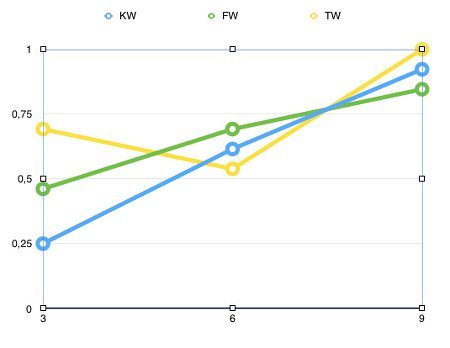
Figure 3: Average probability to stick as a function of time for different wall types: Kitchen (blue), Window (green), Whiteboard (Yellow). Standard deviation is of the order of 0.5 for times 3 and 6 minutes, while it drops to about 0.3 in the first two cases and to 0 in the Whiteboard one.
Discussion. A special care has to be paid to the scenario with the whiteboard as it displays an unexpected non-monotonic result: the probability to stick decreases between 3 and 6 minutes. To investigate such behavior and be sure we are not introducing some unwanted bias in our investigation, we analyzed the average probability of success and standard deviation of each thrower, as reported in Figure 4. As it can be seen, these two quantities are homogenous among all throwers but one (our youngest brave thrower), who has almost 100% probability of success. Assuming that this is not a statistical fluctuation but a bias for which data shall be corrected for, almost cures the non-monotonic behavior of the whiteboard data. However, it does not change the overall conclusions of our work, and thus we consider this a strong signal that our data acquisition is bias free.
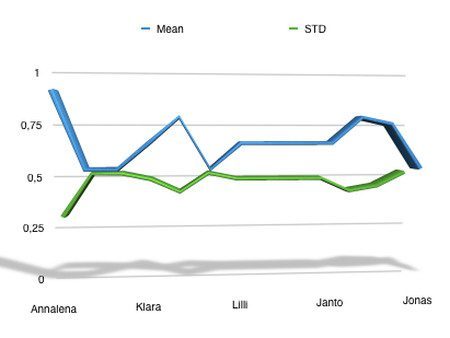
Figure 4: Average probability (blue) standard deviation (green) for all launches of each thrower.
Conclusions. In conclusion, the SOWS rule shall be refused in any “reasonable” kitchen or restaurant unless a huge amount of spaghetti is wasted in statistical tests. It is indeed more efficient to rely on the cooking time reported on the box. An alternative possibility to avoid waste is that the spaghettis are eaten after being stuck on the wall or fallen onto the floor as we have experienced in our experiment! We stress that this is a clear example where the “common knowledge” shall be carefully used and thus we urge the reader never to believe simple truths even if widespread accepted. We think that our study demonstrated once more the importance of the scientific method, which can be used to improve all important steps of our life starting from a good spaghetti meal.
Acknowledgments. This work has been part of a program for preschooler kids to explain how their parents spend time at work (but not always throwing spaghetti!) and to introduce them to the scientific method. We thank the teachers and the throwers of the preschool class of the Ulm University Kindergarden (Annalena, Giorgio, Jonathan, Klara, Lilith Milou, Jannes, Lilli, Finn, Marietta, Janto, Sophie, Moritz, Jonas) for their dedication, passion and throwing precision.

October 21, 2016
Dr. Nakamats’s new invention: Extra-functional eyeglasses
Dr. Nakamats, the world’s most prolific (more than 3500 patents) inventor, and winner of the 2005 Ig Nobel Prize for nutrition, had just obtained yet another patent. His Extra-functional eyeglasses function as traditional eyeglasses do, and also perform extra services for the person wearing them. The invention exists in several different flavors:
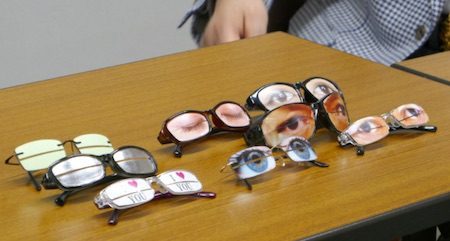
Night-walking glasses, which provide light when the surroundings are dark changing-eye-color glasses, for the person who wishes to appear to have a new eye color
Silent-communication glasses, for the person who is too shy to speak words but would not mind having the glasses display printed words and thoughts
Hiding-eye-wrinkles-glasses, for the person who wishes to hide eye wrinkles
Conference-glasses, for the person who is tired, and wishes to sleep unnoticed during a meeting
Here are some technical drawings from the patent document:
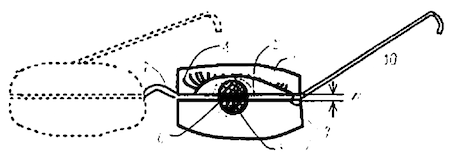
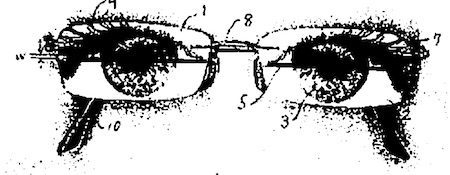
Here is the inventor modeling his Silent-communication glasses:
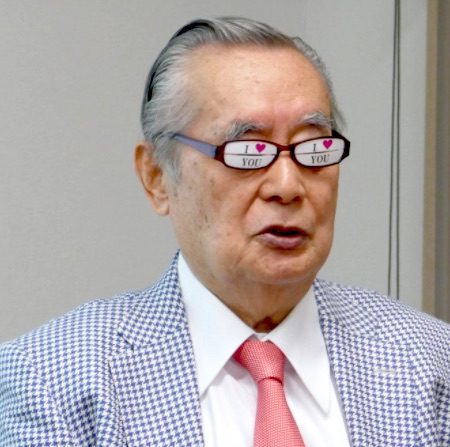
And here is the inventor, modeling his Night-walking glasses:
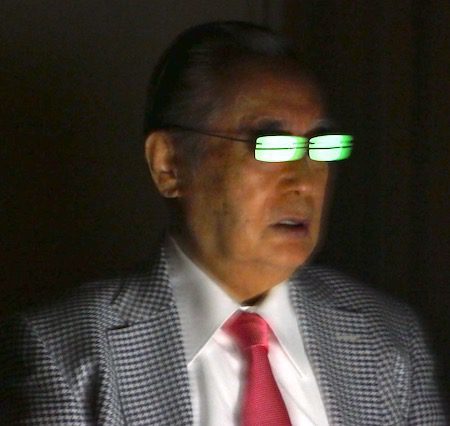
VIDEO: Dr. Nakamats sent us action video of him modeling the various forms of the invention. You can watch it on the Improbable Research Facebook page:
Ps. Dr. Nakamats informs us that he is “still not dead”. [For background on that see the report called “Dr. Nakamats, Continued!“]

Master bullshit analyst graduates, heads off to Yale
The University of Waterloo celebrated the graduation of Gordon Pennycook, who last month, together with his colleagues, was awarded the Ig Nobel Peace Prize. The university writes:
Psych scholar whose research gained global attention graduates
Gordon Pennycook published research on everything from BS to how smartphone use is linked to lazy thinking. Now he’s on a postdoctoral fellowship at Yale University
…Pennycook, who graduates this week with a doctorate in psychology from Waterloo, is currently at Yale University on a prestigious Banting postdoctoral fellowship. He will receive the Alumni Gold Medal for outstanding academic achievement at Waterloo’s 113th convocation ceremonies taking place on Friday October 21 and Saturday October 22.
The numerous studies he led and co-authored while a graduate student explore topics such as religious belief, moral judgments and values, creativity, smartphone use, health beliefs, science communication, and bullshit receptivity. The last of these studies, titled “On the reception and detection of pseudo-profound bullshit,” won a 2016 Ig Nobel Peace Prize, awarded to Pennycook and his co-authors just last month at Harvard University.
“We are not nearly as good at detecting bullshit as we think,” wrote Pennycook in a non-academic online publication.
The BS paper attracted plenty of media coverage and interviews, most recently on the current US election….

How to ‘cheat’ at sport without really ‘cheating’ – part 2: Placebos
 In the previous item in this series Improbable looked at the question of whether ‘praying to win’ at sports might be ‘unsporting’. One aspect (which wasn’t mentioned) is a possible scenario whereby those who pray to win might gain an advantage by a kind-of ‘Divine Placebo’ effect – that’s to say they might try just that little-bit-harder believing that their God is on their side (irrespective of whether their God exists, and, if so, responds to their request). In contrast to ‘pray to win’, there is a considerable body of published academic research into placebo effects in sport. An overview was provided by Dr Christopher Beedie [pictured] and colleague Abigail Foad at Canterbury Christ Church University Canterbury, UK : ‘The Placebo Effect in Sports Performance A Brief Review’ in: Sports Medicine, 39(4):313-29.
In the previous item in this series Improbable looked at the question of whether ‘praying to win’ at sports might be ‘unsporting’. One aspect (which wasn’t mentioned) is a possible scenario whereby those who pray to win might gain an advantage by a kind-of ‘Divine Placebo’ effect – that’s to say they might try just that little-bit-harder believing that their God is on their side (irrespective of whether their God exists, and, if so, responds to their request). In contrast to ‘pray to win’, there is a considerable body of published academic research into placebo effects in sport. An overview was provided by Dr Christopher Beedie [pictured] and colleague Abigail Foad at Canterbury Christ Church University Canterbury, UK : ‘The Placebo Effect in Sports Performance A Brief Review’ in: Sports Medicine, 39(4):313-29.
The team describe previous studies which found (for example) that sub-elite runners who thought they were drinking ‘super oxygenated water’ ran 8.0% faster. Sub-elite weight lifters who believed they were getting doses of anabolic steroids managed 9.5% more weight than a control group. And untrained students performing leg-presses and who were under the impression that they were taking a special blend of ‘amino acids’ performed a stonking 9.6% more effectively.
Since the paper was published (2009), two subsequent studies have added to the literature :
(Study 1) Relates that 47% of athletes have experienced placebo effects in the past, and 67% wouldn’t mind a placebo-linked deception if it was effective, and :
(Study 2) Which described how 44% of professional coaches admitted to administering a placebo to their athletes.
Coming soon: How to ‘cheat’ at sport without really ‘cheating’ – part 3

Marc Abrahams's Blog
- Marc Abrahams's profile
- 14 followers


